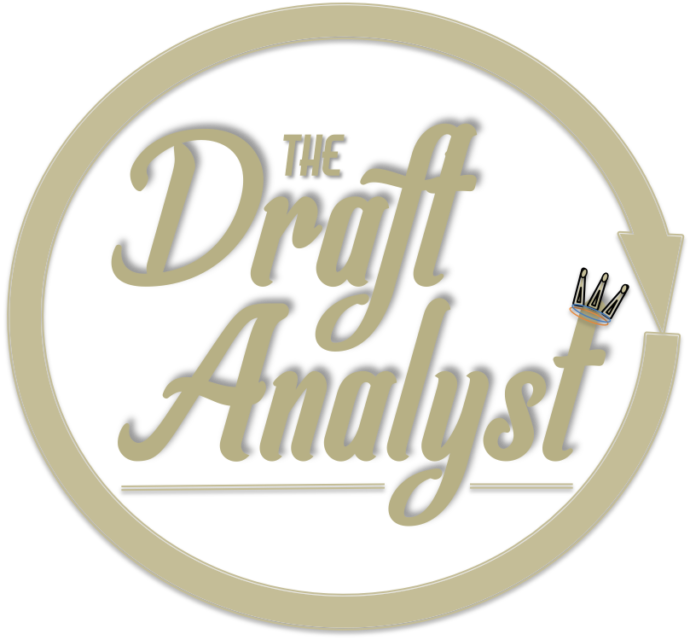2015 U18 Ivan Hlinka Memorial Cup Recap
by Steve Kournianos
August 24th, 2015
steve.kournianos@thedraftanalyst.com
Tweet
by Steve Kournianos
August 24th, 2015
steve.kournianos@thedraftanalyst.com
Tweet
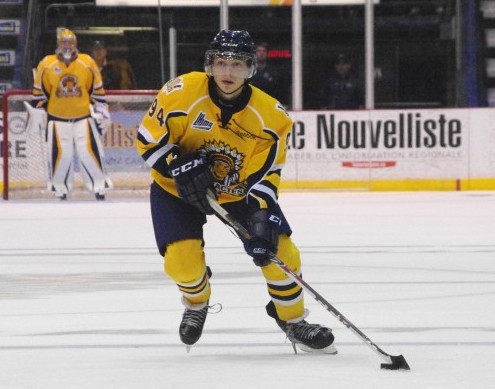
Top Player: LW Tyler Benson (2016) was every bit of the complete player he was a year ago for the Vancouver Giants, only you could see how much he relished the top-line role on a ridiculously deep Canadian team which won its eighth straight Hlinka crown. Benson, the top pick in the 2013 WHL Bantam Draft, was at his best in open ice. But keep in mind that it was he who was creating the open ice with elite puckhandling, keen vision and acute on-ice awareness. It’s pretty hard for a Canadian amateur at any Hlinka, past or present, to distinguish himself above his peers, but we feel Benson did just that.
Key Moment: G Dylan Wells (2016) split time with G Carter Hart (2016) for Team Canada’s goalie duties, but it was Wells who was called upon to keep their hopes alive for an eighth straight Hlinka in a nail-biting shootout with Russia in the semifinal. The Mississisauga Steelhead was phenomenal when tested, and the poise and confidence he displayed while stopping all three of Russia’s attempts in the ever-crucial tiebreaker proved just that.
Who Impressed: LHD Samuel Girard (pictured) and LW Dillon Dube (2016) are two high-end draft eligibles who took on a support role for Team Canada, but did so with aplomb. Girard is a fantastic offensive blueliner who passed the puck with authority, but his decision-making and ability to dictate the tempo of the game was a thing to watch. Dube is a highly-skilled two-way sparkplug who was outstanding on the penalty kill, using his speed and tenacity to force turnovers and create chances.
Who Disappointed: We can’t nitpick a team who went a perfect 5-0 while outscoring its opponents, 23-7 and owning the territorial advantage by a significant margin. In a tournament featuring the cream of the amateur crop, however, there were a handful of players who had the chances but simply couldn’t finish. C/LW Brett Howden (2016) was tremendous in creating chances from winning his puck battles, but his shot accuracy and hands from in close didn’t paint him as an elite prospect. On defense, both RHD Dante Fabbro (2016) and LHD Kale Clague (2016) were active puck movers and solid in coverage but missed the net on far too many chances, specifically with open shooting lanes.
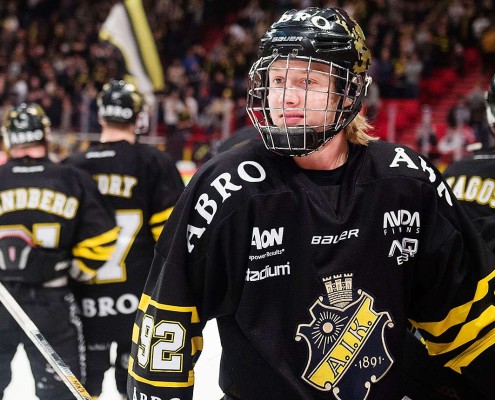
Top Performer(s): C Alex Nylander (pictured) and LW William Fallstrom (2016) were simply dynamic playing on Sweden’s top line; relentless in their pursuit of the puck and extremely sound in the plays they created off the rush, specifically on zone entries in which they made the most out of the limited options presented to them. They both showed a proclivity for shooting off the pass and/or putting themselves in a position to receive and fire.
Key Moment: Fallstrom’s redirect of Nylander’s long shot gave Sweden a 2-1 lead midway through the third period of their semifinal match with Finland. But it was G Filip Gustavsson’s (2016) 21-save performance in the first period which not only prevented Sweden from experiencing a disastrous outcome, but clearly altered the Finns’ mindset on how they attacked him from that point forward.
Who Impressed: Gustavsson had already stolen most of the headlines from the 2014 U17 World Hockey Challenge thanks to what was essentially an entire team piggybacking on their goalie towards a bronze medal. At this year’s Hlinka, the 2016 draft eligible was superb in his first four games before a Canadian blitzkrieg in the gold medal game sent him to the proverbial showers. At 6’2, Gustavsson rarely provided a glimpse of an opening, leading to what seemed like an inordinate amount of shots fired wide, especially from the slot and on breakaways. Lightning quick on his feet with exceptional side-to-side movement, he’s already proven himself on the international stage. Now it’s just a matter of time until he makes his mark in Sweden’s premier league and possibly the 2016 WJC’s.
Who Disappointed: LHD Jacob Moverare is a late-1998 birthday defenseman who has offensive ability but looked like he wanted to play it safe the entire competition sans a few spurts in the 2-0 win over the Czechs. And while he is a big and mobile blueliner, he simply passed up too many opportunities to make impact plays in the offensive zone. Missing the two most important games of the tournament with a fever didn’t help.
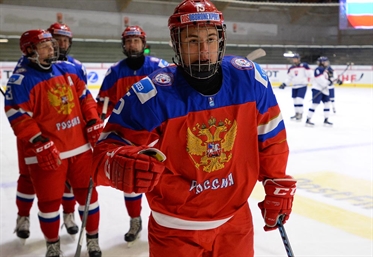
Top Player: G Vladislav Sukhachyov (2016) was stellar from wire-to-wire, but it was a performance against Team Canada in the semis which had most of the hockey world asking who the heck “that Russian goalie” was. Sukhachyov, who is eligible for the 2016 draft and will play for the MHL’s Chelyabinsk club, did not start every game for the Russians but displayed some serious side-to-side quickness and cat-like reflexes. He’s listed at only 5’9 and plays on his feet more than you’d think, so he’s sort of an anti-cookie cutter goaltending prospect who tend to be tall and play a natural butterfly. He’s got a ways to go until we can consider him a top-tier 2016 prospect, but what is certain is that he’s done enough to at least get into the conversation.
Key Moment: Russia may have been tied 1-1 with Canada after 40 minutes of their semifinal meeting. but it could have been worse had it not been for “Fortress” Sukhachov’s aforementioned heroics. In fact, the Russians began to take the play to the Canadians early in the third period, and came ever so close to taking the lead. An ill-timed change by RHD Dante Fabbro was exacerbated by LHD Jake Bean‘s turnover which sprung C Nikita O. Popugaev (2016) up the ice after a nifty swipe and headman from LW Mikhail Meshcheryakov. The wiry sniper took advantage of the open ice and rifled one past G Dylan Wells‘ glove and off the crossbar, keeping the score tied and allowing Canada to maintain the initiative.
Who Impressed: C German Rubtsov was Russia’s best all-around forward in several categories, but what we liked most was the excellent mobility he displayed, not just off the rush but when confronted with seemingly fruitless situations. He kept opponents guessing because he can beat you in a variety of ways; Rubtsov has an excellent shot he rips with accuracy while being checked. He can also dish with some flair — on several occasions he no-looked some tape-to-tape beauties, and through traffic no less. All this coming from a kid who was used in all situations and did so with effectiveness. In our view, he’s an inch or two away from being the complete package, but for now just accept him for being a pretty electrifying playmaker and scorer.
Who Disappointed: LHD Dmitri Alexeyev (2016) was a player we had to view isolated so many times to confirm or deny initial observation of what looked to be relatively lifeless play. Well, going “iso” on him on several occasions, namely the entire game versus Canada, revealed a defender who was in fact playing tentative and was rarely, if ever, taking chances when situations called for one. For example, on several shifts we saw opposing wingers make the cardinal error of cheating below the goal to assist in lost board battles, leaving the slot open and presenting the Russian point men the opportunity to sneak through the breach undetected. Not once did we see Alexeyev take advantage of such an opportunity, which were aplenty throughout the tournament. On the defensive side of the puck, he rarely used his body to separate enemy forwards from the puck, nor did he provide consistent puck support with communication. We saw him wander a ton, which would have been fine if it were below the opposing blue line.

Top Player: LW Otto Makinen (2016) looked like a teenager possessed during the Hlinka, tying for a tournament-best four goals in five games. He displayed some incredible patience and skill from tight spaces while showcasing nifty moves and playing with passion and desire. To be fair, this was his second go-round at the Hlinka, which helped in the expectation management department. But in a competition dominated by stellar goaltending and missed chance after missed chance, it was nice to see somebody make the most of their scoring opportunities.
Key Moment: Favored to represent Group “B” in the title game, the Finns found themselves in a dogfight in the semifinals with Sweden, which scratched and clawed its way to a 1-1 tie midway through the second. C Aapeli Rasanen (2016) had been giving the Swedes (among others) fits all evening, but his breakway in the middle frame failed to break the deadlock, setting the stage for Sweden to hold on before scoring the decisive blow in the third period and ending Finland’s quest for Hlinka gold.
Who Impressed: Rasanen was outstanding the entire competition, dishing out passes, wiring snipes off the rush and engaging himself in any activity near the puck regardless of which zone it found itself in. His decision making, however, was seriously impressive for any player of any age. It’s just not common to see a teenager actually communicate — spoken or instinctive — with teammates during all situations. If he sniffed out an opportunity, you could tell his fellow Finns were reacting to his reaction. We think the 6’0, 195-pound Rasanen is strong enough to merit Liiga consideration, but being a summer 1998 birthday likely keeps him in their junior U20 circuit another season.
Who Disappointed: C Otto Sompi (2016) was somebody who presented himself at the 2014 as a game-breaking type of playmaker who preyed on mistakes and quickly turned them into punishing results. The future Halifax Moosehead (19th overall in 2015 CHL Import Draft) scored a slam dunk goal at the side of the cage in the opening-game win over the Americans, but was unable to bury any additional chances (and he certainly had them) the remainder of the competition. Don’t get us wrong; he was consistently aggressive and difficult to check. The issue was simply an inability to not only bury his chances, but make the kind of high-end skill plays we saw him whip up at the U-17’s. As a center, you can overlook it if he is doing everything else right (which he was). But at 6’1, 185-pounds, the physical advantage he enjoyed in a best-on-best should have yielded better results.
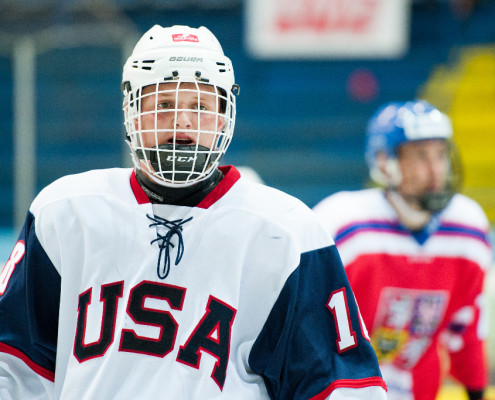
Top Player: LW Casey Mittelstadt (pictured) is not draft eligible until 2017, but he was clearly the most dangerous American player on the ice at any given time during the bulk of the competition. Blessed with excellent hands and a heavy shot, the Minnesota-bound winger kept opponents on their toes with a variety of moves both on the rush and in tight spaces. He was the only power forward on his team to consistently use his size and reach to his advantage, and onlookers were quickly made aware of his compete level and high-level skill.
Key Moment: For the first 30-plus minutes of their preliminary round game against Russia, the Americans looked like they rebounded from an abysmal loss to Finland the previous night. With the score tied at one, RW Riley Tufte (2016) and C Pat Harper (2016) had glorious chances to give Team USA its first lead of the tournament, the latter in the form of a penalty shot with the score tied 1-1. But Russia goalie Vladislav Sukhachyov stoned Tufte’s one timer with a sliding stop, then later thwarted Harper’s stuf-in attempt on the penalty shot. Russia would later kill off a critical penalty, then score a backbreaking power play goal with RW Willie Knierim (2016) in the box and just 21 seconds left in the second period. Russia would go on to win, 5-2, and effectively eliminate the U.S. from medal contention.
Who Impressed: C Ben Lown (2016) and C John Leonard (2016) are two undersized forwards who seemed to be the only two playmakers who didn’t force things, opting for the smart or safe plays in the face of relentless pressure. Neither player was gifted open ice; they made the most of what was presented to them, which is significant considering how poor the Americans were at collectively beating the forecheck and establishing any sort of offensive rhythm. LW Tim Gettinger (2016) took a while to get going but was dangerous below the dots, using his size and strength to fend off defenders and get into prime scoring position.
Who Disappointed: Team USA’s defense as a group were abysmal at handling the cycle and initiating breakouts. On a few occasions, we saw individualistic plays where something was made out of nothing. But the end-to-end rushes were the exception to the rule in this tournament, and the inability to connect on passes and deal with pressure with poise and smarts ultimately cost the Americans a chance at a medal.

Top Player: Defensemen Libor Hajek (pictured) was as good as advertised, and then some. Picked second overall by the WHL’s Saskatoon Blades in the 2015 CHL Import Draft, Hajek was the Czech Republic’s most reliable defender, anchoring the top pairing while he matched up against some of the world’s best U18 forwards. More impressive was his confidence and ability to grab the puck, lug it through a maze of forecheckers while maintaining complete control. In fact, there were several instances where the puck looked stuck to his stickblade with an industrial-strength adhesive. Hajek is without a doubt a WJC candidate and an early season first round projection for 2016.
Key Moment: Tomas Psenicka’s penalty shot late in the 2nd was stopped by Filip Gustavsson in a scoreless tie, with the winner earning the right to go to compete for a medal in the semifinals against Finland. The Swedes wound up blanking the Czechs, 2-0, en route to a silver medal while the Czechs lost to the Americans in the placement game to finish a disappointing sixth.
Who Impressed: Defensemen Vojtech Budik was one of the tournament’s most dynamic playmakers from the back end, but was far more impressive in the way he played in the offensive zone without the puck. Although the Czechs were often caught running around in their own end and guilty of an obscene amount of ill-timed risks, Budik acted as if he was a fourth forward, darting around defenders and bursting into open lanes to receive a pass. And while he was to blame for some costly mistakes which resulted from overhandling the puck, he looks so darn good doing it, you’re willing to let it slide.
Who Disappointed: When defenseman Frantisek Hrdinka was on his game, he looked like a world-beater: attacking the net, darting up the ice and making slick plays to avoid pressure. Those moments, however, were few and far between, as he was indecisive on his pinches, misplayed his one-on-one’s and odd-man rushes, and did not resemble the consistent defender he was in previous competitions.
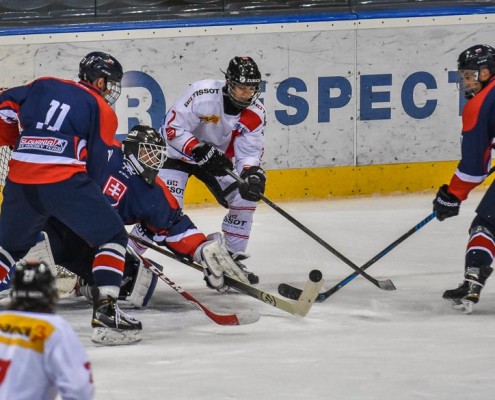
Top Player: C Nico Hischier is an undersized 2017 eligible who anchored Switzerland’s top line and top power play unit, drawing comparisons to 2015 NHL draftee Denis Malgin in terms of skill but outperformed him in terms of their respective Hlinka’s. Quick but not fast, he was simply a joy to watch every time he was on the puck, and in our view was the best stickhandler in the tournament.
Key Moment: RHD Axel Andersson’s first two periods of Switzerland’s opener against the Swedes went according to plan – he was positionally sound, physical when he had to be and impressively accurate with his breakouts. In the third period, however, Andersson was ejected for kneeing Sweden’s Linus Lindstrom with just under three minutes left in a game the Swiss battled back from two goals down to tie the score at three. Switzerland almost turned the negative into a massive positive when Hischier was awarded a penalty shot for being slashed on a shorthanded breakaway. Gustavsson would stop the ensuing chance, and defenseman RHD Jacob Cedarholm made the Swiss pay after he took an entry feed from Fallstrom, juked around a defender and rifled a shot over Wuthrich’s glove hand to win the match for Sweden.
Who Impressed: LHD Livio Stadler meshed well with Switzerland’s skill forwards, who always seemed to be looking for him either trailing a play or sneaking into the high slot. He’s got great offensive instincts, something we didn’t see much of while he served as a depth defenseman at the 2015 U18’s last April. The Swiss are generally top heavy in terms of NHL upside, and we have no problem putting Stadler at the very top of their 2016 draft eligible totem pole.
Who Disappointed: Goaltender Philip Wuthrich wasnt expected to be some sort of savior, leading the Swiss to unprecedented Hlinka glory. He is, however, considered one of the better international goalie prospects for the 2016 draft, so when his final tournament goals against average (5.59) looked more like the Coors Field earned run average of the Colorado Rockies’ fifth starter, it made you wonder if the high-flying Swiss would have vied for a medal had they received solid netminding.

Top Player: RHD Martin Bodak (2016) looked confident in the face of a continuous onslaught, but it was his decisiveness in the offensive zone which stood out to us. Although the Slovak blueline lacked offensive punch as it was loaded with static, positional defenders while the rest of the countries represented stacked their respective defense corps with mobile puck distributors, Bodak made his money getting open to receive passes and quickly hammering shots from the high slot and points. And while Bodak can and should be considered a puck mover, he looked more comfortable whipping long breakout passes through small gaps in the opposing forecheck from below his own circles. He was also quick to identify sloppy/risky line changes, and on several occasions made the other team pay for being lackadaisical. The 6’0, 190-pound blueliner will play for Tappara in the Finnish U20 league next season.
Key Moment: The Slovaks were not given much of a chance in the tournament despite essentially playing all home games with the crowd on their side, so it wasn’t too much of a shock to see them trail Russia early into their tournament-opening contest. The Slovaks battled back to tie the score at one, but dozed off on the very next shift which led to the go-ahead Russian goal and the first of four consecutive Hlinka defeats. LW Jakub Lacka (2017) played matador defense on RW Artem Ivanyuzhenkov’s rush, and LHD Martin Krempansky (2016) lost sight of a loose puck in his skates which allowed C Danil Veriayev to snap home the goal which essentially ended Slovakia’s tournament barely after it began.
Who Impressed: C Milos Roman (2017) and LW Samuel Solensky (2016) were both as solid as they could be for a team which looked overmatched the entire tournament. Roman is a gifted playmaker who showed creativity when faced with impending danger, and doing so in tight spaces. Solensky, who played for Slovakia in both the 2014 U17’s and U18’s, is not very fast but displayed great instincts and a knack for eluding defenders near the goal mouth while their backs were turned.
Who Disappointed: LW Samuel Bucek (2017) was electrifying at times, shifting gears and blowing past defenders while displaying a soft touch and accurate passes. The problem was that he made it obvious he didn’t care for anything else. He was a bit selfish during board battles, refusing to become physically engaged on a few occasions when he could have lent a teammate or two an extra hand. Some players come to these tournaments for the sole reason of spotlighting, and we got the impression Bucek was one of them.
| S | M | T | W | T | F | S |
|---|---|---|---|---|---|---|
| 1 | 2 | 3 | 4 | 5 | 6 | |
| 7 | 8 | 9 | 10 | 11 | 12 | 13 |
| 14 | 15 | 16 | 17 | 18 | 19 | 20 |
| 21 | 22 | 23 | 24 | 25 | 26 | 27 |
| 28 | 29 | 30 | 31 | |||

 2015 U20 Four Nations Tournament Recap (Dmitrov, Russia)
2015 U20 Four Nations Tournament Recap (Dmitrov, Russia) 